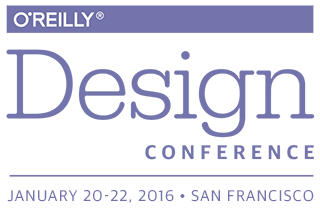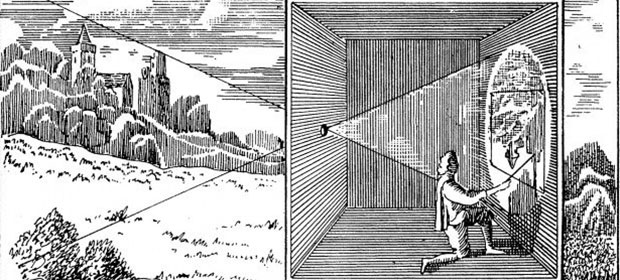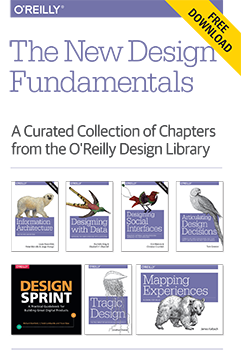"Experience Design and the Internet of Things" entries

Design is how users feel when experiencing products
The O’Reilly Design Podcast: Cindy Alvarez on emotion, user research, and why Craigslist is great design.
Subscribe to the O’Reilly Design Podcast, our podcast exploring how experience design — and experience designers — are shaping business, the Internet of Things, and other domains.
 In this week’s Design Podcast episode, I sit down with Cindy Alvarez, a designer at Microsoft, author of Lean Customer Development, and member of our program committee for O’Reilly’s first design conference.
In this week’s Design Podcast episode, I sit down with Cindy Alvarez, a designer at Microsoft, author of Lean Customer Development, and member of our program committee for O’Reilly’s first design conference.
Alvarez talks about how design is changing, how the approach to design at Microsoft is changing, and user research misperceptions and challenges. She also offers advice to those who are insisting all designers should code.
Here are a few highlights from our chat:
Steve Jobs has said that, “Design is not how it looks, it’s how it works.” I would go one step further and say, “Design is how you work.” When you’re using something, how do you feel … How are you feeling more capable — do you feel smarter? Do you feel stronger? Do you feel stupider? Design is how you feel when you are using things or having experiences.
The ‘butt-brush’ effect comes from the wonderful Paco Underhill book Why We Buy. … Specifically, the butt-brush phenomenon is people looking at products that they really wanted to buy, but the store layout made it so people were bumping into them. That was such a strong push to get them to abandon what they were doing … that they’d just get up and walk away. He theorized about people feeling vulnerable, and undoubtedly there’s some sort of evolutionary thing about woolly mammoths sneaking up on us or something. I think it’s just, on a more base level, people feel clumsy. They feel fat, they feel clumsy and awkward, and we don’t like that at all.

Tweaking personas: Mastering the hunt for the ideal user
Personas are a useful tool, almost always used badly.
Register for the UX Design for Growth — Improving User Conversion training session with Laura Klein. In this online, interactive training workshop, Klein, author of “UX for Lean Startups,” will teach you to design for product growth.
Personas have always struck me as a potentially useful tool that is almost always used badly. In theory, they’re great. Who doesn’t love a deliverable that is designed to get everybody on the team more familiar with the ideal user? Why wouldn’t we create something to help us focus our design and engineering efforts around the real people using our products?
Unfortunately, the reality rarely lives up to the hype. Personas, as they are created in many organizations, aren’t nearly as useful as they could be. They’re rarely based on real user insights developed during research. They tend to be overly broad and generalized. They’re descriptive, rather than predictive. And that’s just a few of the things people get wrong. Read more…

Privacy and security are every UX designer’s responsibility
The O’Reilly Design Podcast: Ame Elliott on UX privacy and security, and how architecture informs her design work.
Subscribe to the O’Reilly Design Podcast, our podcast exploring how experience design — and experience designers — are shaping business, the Internet of Things, and other domains.
 In this week’s Design Podcast episode, I sit down with Ame Elliott, design director at Simply Secure. She addresses the relationship between — and challenges of — privacy and security, noting “there’s plenty of tough to go around.”
In this week’s Design Podcast episode, I sit down with Ame Elliott, design director at Simply Secure. She addresses the relationship between — and challenges of — privacy and security, noting “there’s plenty of tough to go around.”
Elliott also talks about how her experience of attending architecture school informs her design work, and looks at the responsibility of designers to create for a greater good.
Here are a few highlights from our chat:
I think architecture can be a wonderful form of a design-inspired liberal arts education. If you look at places like Italy, I think there are certainly ways that you can go to architecture school and not be set up to practice architecture. The studio experience of actually being together in this communal space, working on a drafting table, making things visual — it’s so foundational to a lot of the things that are called ‘design thinking’ today.
Privacy or confidentiality is one technical goal of security. There are other technical goals of security: integrity, non-reputability, and other kinds of things. Coming at this from a human-centered design perspective … I care about what end users experience, and privacy feels like the quality people are looking for in an interaction.

Knowing when not to design
Don’t waste time on features that users don’t want.
Attend “UX Design for Growth,” a training session by Laura Klein that will give you the skills you need to design products that convert and retain users.
After many years as a designer, I’ve realized that some of the most important design decisions have nothing to do with what any of us consider design. Instead of designing the perfect version of a feature, sometimes the best thing we can do is learn that we shouldn’t build the feature in the first place.
In my all-day, online workshop on September 15, 2015, I’ll be talking about another aspect of building products: how to make them grow. Potentially fabulous products fail every day because product managers and UX designers don’t spend enough time thinking about how their product is going to be discovered by new users.
The following is an excerpt from my book, UX for Lean Startups, where I give one practical tip for learning whether or not you should build a specific feature for your product. If you’d like some practical tips on getting people to start using all those features you decide to build, please join me on September 15th for my UX Design for Growth training session. Read more…

Our world is full of bad UX, and it’s costing us dearly
We need to provide people with proper access, interaction, and use of technology so that it serves their needs.
Download a free copy of “The New Design Fundamentals,” a curated collection of chapters from the O’Reilly Design library. Editor’s note: this post is an excerpt from “Tragic Design,” by Jonathan Shariat, which is included in the collection.
I love people.I love technology and I love design, and I love the power they have to help people.
That is why when I learned they had cost a young girl her life, it hurt me deeply and I couldn’t stop thinking about it for weeks.
My wife, a nursing student, was sharing with her teacher how passionate I am about technology in health care. Her teacher rebutted, saying she thought we needed less technology in health care and shared a story that caused her to feel so strongly that way.
This is the story that inspired me to write this book and I would like to share it with you.
Jenny, as we will call her to protect the patient’s identity, was a young girl who was diagnosed with cancer. She was in and out of the hospital for a number of years and was finally discharged. A while later she relapsed and returned to be given a very strong chemo treating medicine. This medicine is so strong and so toxic that it requires pre-hydration and post-hydration for three days with I.V. fluid.
However, after the medicine was administered, the nurses who were attending to the charting software, entering in everything required of them and making the appropriate orders, missed a very critical piece of information: Jenny was supposed to be given three days of I.V. hydration post treatment. The experienced nurses made this critical error because they were too distracted trying to figure out the software they were using.
When the morning nurse came in the next day, they saw that Jenny had died of toxicity and dehydration. All because these very seasoned nurses were preoccupied trying to figure out this interface (figure 1-1). Read more…

Designing with all of the data
More than just filling in where big data leaves off, thick data can provide a new perspective on how people experience designs.
Download a free copy of our new report “Data-Informed Product Design,“ by Pamela Pavliscak. Editor’s note: this post is an excerpt from the report.
There is a lot of hype about “data-driven” or “data-informed” design, but there is very little agreement about what it really means. Even deciding how to define data is difficult for teams with spotty access to data in the organization, uneven understanding, and little shared language. For some interactive products, it’s possible to have analytics, A/B tests, surveys, intercepts, benchmarks, scores of usability tests, ethnographic studies, and interviews. But what counts as data? And more important, what will inform design in a meaningful way?When it comes to data, we tend to think in dichotomies: quantitative and qualitative, objective and subjective, abstract and sensory, messy and curated, business and user experience, science and story. Thinking about the key differences can help us to sort out how it fits together, but it can also set up unproductive oppositions. Using data for design does not have to be an either/or; instead, it should be yes, and…
Big data and the user experience
At its simplest, big data is data generated by machines recording what people do and say. Some of this data is simply counts — counts of who has come to your website, how they got there, how long they stayed, and what they clicked or tapped. They also could be counts of how many clicked A and how many clicked B, or perhaps counts of purchases or transactions.
For a site such as Amazon, there are a million different articles for sale, several million customers, a hundred million sales transactions, and billions of clicks. The big challenge is how to cluster only the 250,000 best customers or how to reduce 1,000 data dimensions to only two or three relevant ones. Big data has to be cleaned, segmented, and visualized to start getting a sense of what it might mean. Read more…

Designing with best practices, principles, and interaction patterns
It's important for designers to see emerging standards and understand how one experience affects expectations for the next.
Download a free copy of “The New Design Fundamentals” ebook, a curated collection of chapters from our Design library. Note: this post is an excerpt from “Designing Social Interfaces,” by Christian Crumlish and Erin Malone, which is included in the curated collection.
With the growing expectation of seamless experiences, it is important for designers to see the emerging standards and to understand how one experience of a site and its interactions affects expectations for the next site. By working with standard and emerging best practices, principles, and interaction patterns, the designer takes some of the burden of understanding how the application works off the user, who then can focus on the unique properties of the social experience she is building.To start, we do define these three things differently. They live along a continuum, from prescriptive (rules you should follow) to assumptions (a basic generalization that is accepted as true) to process (ways to approach thinking about these concepts).
Principle: A basic truth, law, or assumption
Principles are basic assumptions that have been accepted as true. In interaction design, they can lend guidance for how to approach a design problem, and have been shown to be generally true with respect to a known user experience problem or a set of accepted truths.
For example: be learnable — create systems that are easily learned and provide cues for users to predict how things work from one area to another.
Principles don’t prescribe the solution, though, like an interaction pattern does; instead, they support the rationale behind an interaction design pattern or set of best practices. Read more…

The O’Reilly Design Conference: Design the Future — CFP is now open
The conference will take place January 20-22, 2016, in San Francisco, and we want to hear from you.
Submit a proposal to speak at The O’Reilly Design Conference: Design the Future, our new design conference looking at the convergence of design, programming, and business.
 Last year, I had a conversation with Tim O’Reilly about the emergence of design in unexpected places — in the data community, in the programming community, and in the business community. Design has become increasingly important as technology and bandwidth become commoditized. Our conversation initiated what would become a new program for us here at O’Reilly, and our relatively recent focus on design has reached a milestone: I’m thrilled to announce the first O’Reilly Design Conference: Design the Future, coming to San Francisco in January 2016. Read more…
Last year, I had a conversation with Tim O’Reilly about the emergence of design in unexpected places — in the data community, in the programming community, and in the business community. Design has become increasingly important as technology and bandwidth become commoditized. Our conversation initiated what would become a new program for us here at O’Reilly, and our relatively recent focus on design has reached a milestone: I’m thrilled to announce the first O’Reilly Design Conference: Design the Future, coming to San Francisco in January 2016. Read more…

Designers as data scientists
Data science isn't only the purview of analysts and statisticians; it should be part of a designer's skill set as well.
Download a free copy of “The New Design Fundamentals” ebook, a curated collection of chapters from our Design library. Note: this post is an excerpt from “Designing with Data,” by Rochelle King and Elizabeth F. Churchill, which is included in the curated collection.
It might feel like using data is big news now, but the truth is that we’ve been using data for a long time. For the past 20 years, we’ve been moving and replicating more and more experiences that we used to have in the physical world into the digital world. Sharing photos, having conversations, duties that we used to perform in our daily work have all become digital. We could probably have a separate discussion as to how much the migration from the physical “real” world to the digital world has benefitted or been detrimental to our society, but you can’t deny that it’s happening and only continues to accelerate at a breakneck pace.Let’s take a look at what it means for these experiences to be moving from the physical to the digital. Not too long ago, the primary way that you shared photos with someone was that you would have to have used your camera to take a photo at an event. When your roll of film was done, you’d take that film to the local store where you would drop it off for processing. A few days or a week later, you would need to pick up your developed photos, and that would be the first time you’d be able to evaluate how well the photos that you took many days prior actually turned out. Then, maybe when someone was at your house, you’d pull out those photos and narrate what each photo was about. If you were going to really share those photos with someone else, you’d maybe order duplicates and then put them in an envelope to mail to them — and a few days later, your friend would get your photos as well. If you were working at a company like Kodak that had a vested interest in getting people to use your film, processing paper, or cameras, then there are so many steps and parts of the experience that I just described which are completely out of your control. You also have almost no way to collect insight into your customers’ behaviors and actions along the process. Read more…

Toward a damned good information architecture
An IA model informed by an "information ecology" composed of users, content, and context.
Download a free copy of “The New Design Fundamentals” ebook, a curated collection of chapters from our Design library. Note: this post is an excerpt from “Information Architecture,” 4th Edition, by Louis Rosenfeld, Peter Morville, and Jorge Arango, which is included in the curated collection.
Users. Content. Context. You’ll hear these three words again and again throughout this book. They form the basis of our model for practicing effective information architecture design. Underlying this model is a recognition that you can’t design useful information architectures in a vacuum. An architect can’t huddle in a dark room with a bunch of content, organize it, and emerge with a grand solution. It simply won’t hold up against the light of day.Websites, intranets, apps, and other information environments are not lifeless, static constructs. Rather, there is a dynamic, organic nature to both the information systems and the broader contexts in which they exist. This is not the old world of yellowing cards in a library card catalog. We’re talking complex, adaptive systems with emergent qualities. We’re talking rich streams of information flowing within and beyond the borders of departments, business units, institutions, and countries. We’re talking messiness and mistakes, trial and error, survival of the fittest.
We use the concept of an “information ecology” composed of users, content, and context to address the complex dependencies that exist. And we draw upon our trusty Venn diagram (see Figure 2–6) to help people visualize and understand these relationships. The three circles illustrate the interdependent nature of users, content, and context within a complex, adaptive information ecology. Read more…



